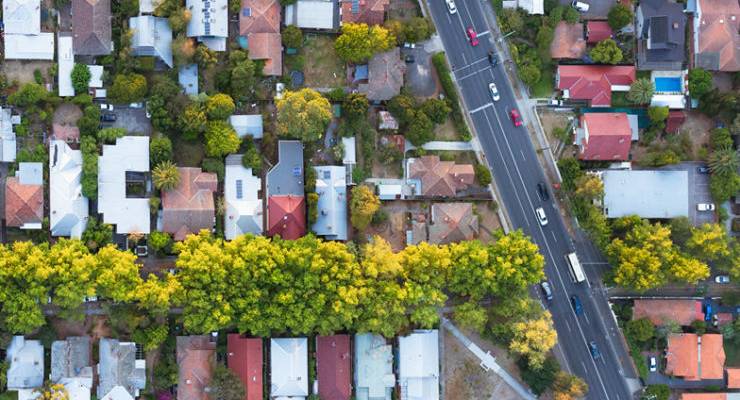
In recent months we’ve seen a doom ‘n’ gloom bidding war on property prices by foreign bank analysts and the media. Last month it was Morgan Stanley claiming the biggest fall since Fraser was prime minister; this week it was UBS and its claim of a 30% price slide. Old mate Martin North reckoned 40-45% earlier in the year on 60 Minutes. Anyone care to bid 50%?
Fairfax and News Corp love it, of course — Fairfax will run a prominent story on literally any two-bit screen jockey who makes a ridiculous claim about property prices.
News Corp owns 61% of REA Group, the country’s biggest property listings website operator, and Fairfax Media owns 59% of Domain, the second biggest. The newspapers and websites of both companies carry dozens of stories a week on property prices, hidden bargains, traps for buyers, tips for young players, the biggest rises and falls — all property-porn clickbait to cash in on our obsession with real estate, especially in Sydney. Expect plenty more when Nine takes over Fairfax and Domain begins working with Nine’s tabloid TV offerings.
But there’s one key figure that discredits the myth of a property crash: home lending was still running at 5.2% annual growth in the year to September, according to the Reserve Bank — still much faster than the 4.4% growth in business lending. Growth in lending for owner-occupiers was over 7%. Some crash. And that’s in a consumer environment of continuing strong jobs growth, albeit with low wages growth unless you work in health, near-record workforce participation and other indicators of a well-performing economy.
Not merely is there no housing crash, but there are few of the macroeconomic factors that would panic mortgage holders and create the environment for one.
In fact, what has been spun as a “crash” could also be seen as enhancing the resilience of the financial system. In remarks to a finance conference in Melbourne recently, Reserve Bank deputy governor Guy Debelle made some pointed comments on the great property plunge beat up.
“I don’t regard it as likely that household borrowing will collapse under its own weight,” he said. “Rather, if a negative shock were to hit the Australian economy, particularly one that caused a sizeable rise in unemployment, then the risk on the household balance sheet would magnify the adverse effect of that shock.”
That is, the primary risk is external, not within our own financial system. Debelle went on to point out that the tougher regulatory line on interest-only lending to owner occupiers and investors and tighter loan-to-valuation ratio rules imposed by APRA in recent years:
have helped to reduce the riskiness of new borrowing. In turn, this has stemmed the increase in household sector vulnerabilities and improved the resilience of the economy to future shocks. The measures have led to a slowing in credit growth but there is little evidence to suggest that the measures have excessively constrained aggregate credit supply. Housing credit growth has slowed, but it is still running at 5%.
And he pointed out one very pertinent fact that the gloom and doom brigade have ignored:
A smaller share of new loans are to investors, are interest-only, have high LVRs or are to borrowers more likely to have difficulty repaying the loan. But it takes time for the riskiness of the stock of outstanding loans to improve. When you implement a change in lending standards the existing loans are no different to how they were the day before. But over time a larger share of outstanding loans will have been written with more stringent lending standards, while the larger share of principal and interest loans will see more of the outstanding loans have a declining balance over time … It is worth remembering that arrears rates remain low.
That the economy is now more resilient to external shocks is anathema to the screen jockeys, professional bears and clickbait peddlers, none of whom are ever stymied by their long history of being wrong over and over again.









Look at who’s spreading this “bovine Dynamic Depressor” :-
* a bloated, real estate industry hooked on such (Howard) middle-class welfare;
* a government that wanted us to believe that a SA black-out (caused by a storm that flattened the power delivery network) was down to “SA’s dependence on renewables”, and that “Labor’s negative gearing policy would decimate home values and the economy” while sitting on, and supressing, Treasury modelling that showed that to be BS; and
* a complicit media more devoted to playing politics than keeping we voters informed?
…… “Yeah. What a ‘great view’. All I’ll need is a helicopter.”
The warning from DeBelle was that U/E would have an “adverse effect” but it is not necessary for the primary risk to be external.
The current, and prospective, government are perfectly capable of making such a balls-up of the economy due mainly to ideological stupidity & bigotry.
Horne’s thesis in the “Lucky Country” – surely one of the least understood books of our time – was that this was a first rate country run by third raters and it is sheer luck that they don’t balls things up more badly, more often.
“our financial sector, and the surrounding economy, have become more resilient in recent years”
Being such an ethical sector I can believe everything they report and I sleep well knowing that they would not risk the national economy for the sake of enormous bonuses.
Property crashes occur with massive increases in unemployment or rapid rises in interest rates – so there is no property crash on the horizon. The sharemarket is another story.